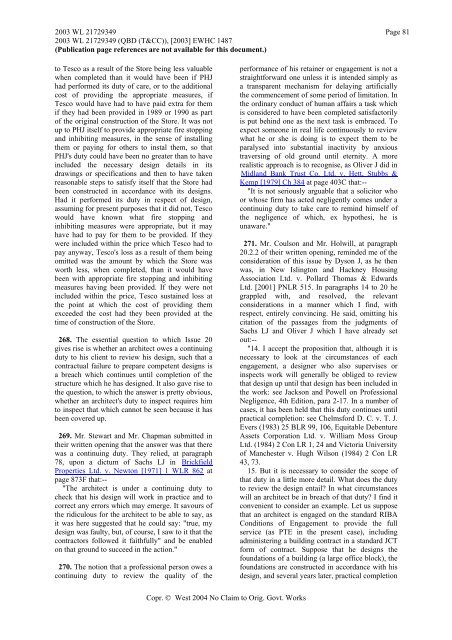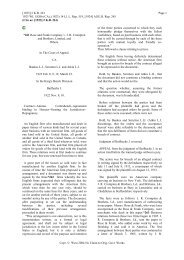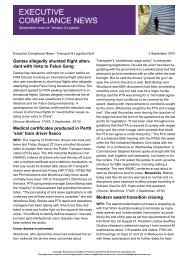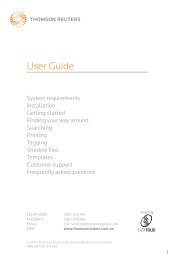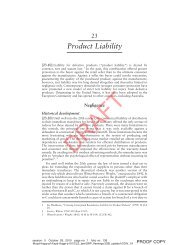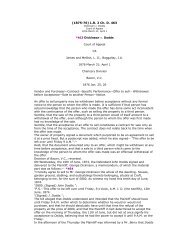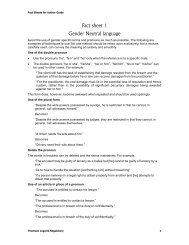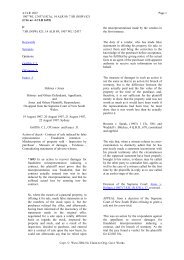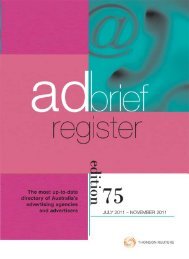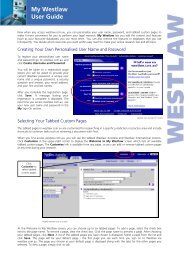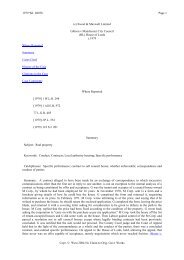Tesco v Constain - Thomson Reuters
Tesco v Constain - Thomson Reuters
Tesco v Constain - Thomson Reuters
Create successful ePaper yourself
Turn your PDF publications into a flip-book with our unique Google optimized e-Paper software.
2003 WL 21729349 Page 812003 WL 21729349 (QBD (T&CC)), [2003] EWHC 1487(Publication page references are not available for this document.)to <strong>Tesco</strong> as a result of the Store being less valuablewhen completed than it would have been if PHJhad performed its duty of care, or to the additionalcost of providing the appropriate measures, if<strong>Tesco</strong> would have had to have paid extra for themif they had been provided in 1989 or 1990 as partof the original construction of the Store. It was notup to PHJ itself to provide appropriate fire stoppingand inhibiting measures, in the sense of installingthem or paying for others to instal them, so thatPHJ's duty could have been no greater than to haveincluded the necessary design details in itsdrawings or specifications and then to have takenreasonable steps to satisfy itself that the Store hadbeen constructed in accordance with its designs.Had it performed its duty in respect of design,assuming for present purposes that it did not, <strong>Tesco</strong>would have known what fire stopping andinhibiting measures were appropriate, but it mayhave had to pay for them to be provided. If theywere included within the price which <strong>Tesco</strong> had topay anyway, <strong>Tesco</strong>'s loss as a result of them beingomitted was the amount by which the Store wasworth less, when completed, than it would havebeen with appropriate fire stopping and inhibitingmeasures having been provided. If they were notincluded within the price, <strong>Tesco</strong> sustained loss atthe point at which the cost of providing themexceeded the cost had they been provided at thetime of construction of the Store.268. The essential question to which Issue 20gives rise is whether an architect owes a continuingduty to his client to review his design, such that acontractual failure to prepare competent designs isa breach which continues until completion of thestructure which he has designed. It also gave rise tothe question, to which the answer is pretty obvious,whether an architect's duty to inspect requires himto inspect that which cannot be seen because it hasbeen covered up.269. Mr. Stewart and Mr. Chapman submitted intheir written opening that the answer was that therewas a continuing duty. They relied, at paragraph78, upon a dictum of Sachs LJ in HBrickfieldProperties Ltd. v. Newton [1971] 1 WLR 862 atpage 873F that:--"The architect is under a continuing duty tocheck that his design will work in practice and tocorrect any errors which may emerge. It savours ofthe ridiculous for the architect to be able to say, asit was here suggested that he could say: "true, mydesign was faulty, but, of course, I saw to it that thecontractors followed it faithfully" and be enabledon that ground to succeed in the action."270. The notion that a professional person owes acontinuing duty to review the quality of theperformance of his retainer or engagement is not astraightforward one unless it is intended simply asa transparent mechanism for delaying artificiallythe commencement of some period of limitation. Inthe ordinary conduct of human affairs a task whichis considered to have been completed satisfactorilyis put behind one as the next task is embraced. Toexpect someone in real life continuously to reviewwhat he or she is doing is to expect them to beparalysed into substantial inactivity by anxioustraversing of old ground until eternity. A morerealistic approach is to recognise, as Oliver J did inHMidland Bank Trust Co. Ltd. v. Hett, Stubbs &Kemp [1979] Ch 384 at page 403C that:--"It is not seriously arguable that a solicitor whoor whose firm has acted negligently comes under acontinuing duty to take care to remind himself ofthe negligence of which, ex hypothesi, he isunaware."271. Mr. Coulson and Mr. Holwill, at paragraph20.2.2 of their written opening, reminded me of theconsideration of this issue by Dyson J, as he thenwas, in New Islington and Hackney HousingAssociation Ltd. v. Pollard Thomas & EdwardsLtd. [2001] PNLR 515. In paragraphs 14 to 20 hegrappled with, and resolved, the relevantconsiderations in a manner which I find, withrespect, entirely convincing. He said, omitting hiscitation of the passages from the judgments ofSachs LJ and Oliver J which I have already setout:--"14. I accept the proposition that, although it isnecessary to look at the circumstances of eachengagement, a designer who also supervises orinspects work will generally be obliged to reviewthat design up until that design has been included inthe work: see Jackson and Powell on ProfessionalNegligence, 4th Edition, para 2-17. In a number ofcases, it has been held that this duty continues untilpractical completion: see Chelmsford D. C. v. T. J.Evers (1983) 25 BLR 99, 106, Equitable DebentureAssets Corporation Ltd. v. William Moss GroupLtd. (1984) 2 Con LR 1, 24 and Victoria Universityof Manchester v. Hugh Wilson (1984) 2 Con LR43, 73.15. But it is necessary to consider the scope ofthat duty in a little more detail. What does the dutyto review the design entail? In what circumstanceswill an architect be in breach of that duty? I find itconvenient to consider an example. Let us supposethat an architect is engaged on the standard RIBAConditions of Engagement to provide the fullservice (as PTE in the present case), includingadministering a building contract in a standard JCTform of contract. Suppose that he designs thefoundations of a building (a large office block), thefoundations are constructed in accordance with hisdesign, and several years later, practical completionCopr. © West 2004 No Claim to Orig. Govt. Works


